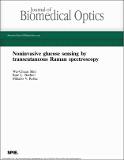Noninvasive glucose sensing by transcutaneous Raman spectroscopy
Author(s)
Shih, Wei-Chuan; Bechtel, Kate L.; Rebec, Mihailo V.
DownloadShih-2015-Noninvasive Glucose.pdf (1.153Mb)
PUBLISHER_POLICY
Publisher Policy
Article is made available in accordance with the publisher's policy and may be subject to US copyright law. Please refer to the publisher's site for terms of use.
Terms of use
Metadata
Show full item recordAbstract
We present the development of a transcutaneous Raman spectroscopy system and analysis algorithm for noninvasive glucose sensing. The instrument and algorithm were tested in a preclinical study in which a dog model was used. To achieve a robust glucose test system, the blood levels were clamped for periods of up to 45 min. Glucose clamping and rise/fall patterns have been achieved by injecting glucose and insulin into the ear veins of the dog. Venous blood samples were drawn every 5 min and a plasma glucose concentration was obtained and used to maintain the clamps, to build the calibration model, and to evaluate the performance of the system. We evaluated the utility of the simultaneously acquired Raman spectra to be used to determine the plasma glucose values during the 8-h experiment. We obtained prediction errors in the range of ∼1.5−2 mM. These were in-line with a best-case theoretical estimate considering the limitations of the signal-to-noise ratio estimates. As expected, the transition regions of the clamp study produced larger predictive errors than the stable regions. This is related to the divergence of the interstitial fluid (ISF) and plasma glucose values during those periods. Two key contributors to error beside the ISF/plasma difference were photobleaching and detector drift. The study demonstrated the potential of Raman spectroscopy in noninvasive applications and provides areas where the technology can be improved in future studies.
Date issued
2015-02Department
Massachusetts Institute of Technology. Spectroscopy LaboratoryJournal
Journal of Biomedical Optics
Publisher
Society of Photo-Optical Instrumentation Engineers (SPIE)
Citation
Shih, Wei-Chuan, Kate L. Bechtel, and Mihailo V. Rebec. “Noninvasive Glucose Sensing by Transcutaneous Raman Spectroscopy.” Journal of Biomedical Optics 20, no. 5 (February 17, 2015): 051036. © 2015 SPIE.
Version: Final published version
ISSN
1083-3668